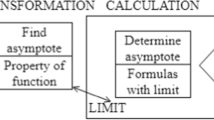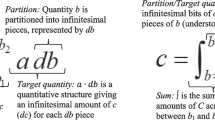Abstract
We propose an approach to the integral concept for advanced high school students and provide evidence for the potential of this approach to support students in acquiring an in-depth proceptual view of the integral. The approach is based on the mathematical idea of accumulation. A ten-lesson unit has been implemented with four pairs of students. The students’ learning processes were micro-analysed using the methodological–theoretical framework of Abstraction in Context. In this paper, we focus on the lessons in which the notions of approximation and accumulation are introduced. The work of one student pair is analysed in detail, and the work of the other pairs is summarized. Our results show that most of the students reached a proceptual understanding of the integral that prepared them for the next step in the curriculum, namely the Fundamental Theorem of Calculus.









Similar content being viewed by others
Notes
Many other relevant research studies had to be left out because of space limitations.
References
Bagni, G. T. (1999). Integral and continuity in high school students’ conceptions. In A. Gagatsis (Ed.), A multidimensional approach to learning in mathematics and sciences (pp. 171–182). Nicosia, Cyprus: Intercollege Press.
Belova, O. (2006). Computer based approach to integral calculus for prospective teachers. Unpublished doctoral dissertation. Krasnoyarsk State Pedagogical University, Krasnoyarsk (in Russian).
Blum, W., & Törner, G. (1983). Didaktik der Analysis. Göttingen: Vandenhoeck & Ruprecht.
Carlson, M., Jacobs, S., Coe, E., Larsen, S., & Hsu, E. (2002). Applying covariational reasoning while modeling dynamic events: A framework and a study. Journal for Research in Mathematics Education, 33, 352–378.
Davydov, V. V. (1990). Types of generalization in instruction: logical and psychological problems in the structuring of school curricula. In J. Kilpatrick (Ed.) & J. Teller (Trans.), Soviet studies in mathematics education (Vol. 2). Reston, VA: National Council of Teachers of Mathematics (original work published in 1972).
Dreyfus, T., Hershkowitz, R., & Schwarz, B. B. (in press).The nested epistemic actions model for abstraction in context. Theory as methodological tool and methodological tool as theory. In A. Bikner-Ahsbahs, C. Knipping & N. Presmeg (Eds.), Doing (qualitative) research: Methodology and methods in mathematics education. Dordrecht: Springer, Advances in Mathematics Education Series.
Dreyfus, T., & Tsamir, P. (2004). Ben’s consolidation of knowledge structures about infinite sets. Journal of Mathematical Behavior, 23, 271–300.
Freudenthal, H. (1991). Revisiting mathematics education. China lectures. Dordrecht: Kluwer.
Goldin, G. A. (2000). A scientific perspective on structured, task-based interviews in mathematical education research. In A. E. Kelly & R. A. Lesh (Eds.), Handbook of research design in mathematics and science education (pp. 517–545). Mahwah, NJ: Lawrence Erlbaum Associates.
Gray, E., & Tall, D. O. (1994). Duality, ambiguity & flexibility: Aproceptual view of simple arithmetic. Journal for Research in Mathematics Education, 26, 115–141.
Grenier, D., Richard, F. O., & Legrand, M. (1990). Un changement de point de vuesurl’enseignement de l’intégrale. Commission interIREMUniversité, Enseignerautrement les mathématiques en DEUG a premiere année (pp. 205–220). LIRDIS: Lyon.
Hershkowitz, R., Schwarz, B. B., & Dreyfus, T. (2001). Abstraction in context: Epistemic actions. Journal for Research in Mathematics Education, 32, 195–222.
Kirsch, A. (1976). Eine intellektuell ehrliche Einführung des Integralbegriffs in Grundkursen. Didaktik der Mathematik, 2, 87–105.
Kouropatov, A., & Dreyfus, T. (2013a). Constructing the integral concept on the basis of the idea of accumulation: Suggestion for a high school curriculum. International Journal of Mathematical Education in Science and Technology, 44, 641–651.
Kouropatov, A., & Dreyfus, T. (2013b). Constructing the Fundamental Theorem of Calculus. In A. Heinze & A. Lindmeier (Eds.), Proceedings of the 37th Conference of the International Group for the Psychology of Mathematics Education Methodology and Methods in Mathematics Education (Vol. 3, pp. 201–209). Kiel, Germany: PME.
Oehrtman, M. (2008). Layers of abstraction: theory and design for the instruction of limit concepts. In M. Carlson & C. Rasmussen (Eds.), Making the connection: Research and teaching in undergraduate mathematics education (pp. 65–80). Washington, DC: MAA.
Schwarz, B. B., Dreyfus, T., & Hershkowitz, R. (2009). The nested epistemic actions model for abstraction in context. In B. B. Schwarz, T. Dreyfus & R. Hershkowitz (Eds.), Transformation of knowledge through classroom interaction (pp. 11–42). London, UK: Routledge.
Sealey, V. (2006). Student understanding of definite integrals, Riemann sums and area under a curve: what is necessary and sufficient? In S. Alvatore, J. L. Cortina, M. Sáiz & A. Mendez (Eds.), Proceedings of the 28th Annual Meeting of the North American Chapter of International Group for the Psychology of Mathematics Education. [CD-ROM]. Yucatan, Mexico: Merida.
Thomas, M. O. J., & Hong, Y. Y. (1996). The Riemann integral in calculus: Students’ processes and concepts. In P. C. Clarkson (Ed.), Proceedings of the 19th Mathematics Education Research Group of Australasia Conference (pp. 572–579). Australia: Melbourne.
Thompson, P. W. (1994). Images of rate and operational understanding of the Fundamental Theorem of Calculus. Educational Studies in Mathematics, 26, 275–298.
Thompson, P. W., & Silverman, J. (2008). The concept of accumulation in calculus. In M. Carlson & C. Rasmussen (Eds.), Making the connection: Research and teaching in undergraduate mathematics (pp. 43–52). Washington, DC: MAA.
Author information
Authors and Affiliations
Corresponding author
Rights and permissions
About this article
Cite this article
Kouropatov, A., Dreyfus, T. Learning the integral concept by constructing knowledge about accumulation. ZDM Mathematics Education 46, 533–548 (2014). https://doi.org/10.1007/s11858-014-0571-5
Accepted:
Published:
Issue Date:
DOI: https://doi.org/10.1007/s11858-014-0571-5




